Farmers began to look at the land in Dakota Territory during the Civil War (1861 – 1865). In the 1870s, people who wanted a family farm could claim a homestead of 160 acres. They could also purchase land in any amount they could afford. Family farms, much smaller than bonanza farms, had an average of 277 acres in 1890. Federal law also allowed a farmer to claim an extra 160 acres by planting trees on part of the land. Farmers took advantage of all these opportunities, and by 1920 the average farm had grown to 466 acres.
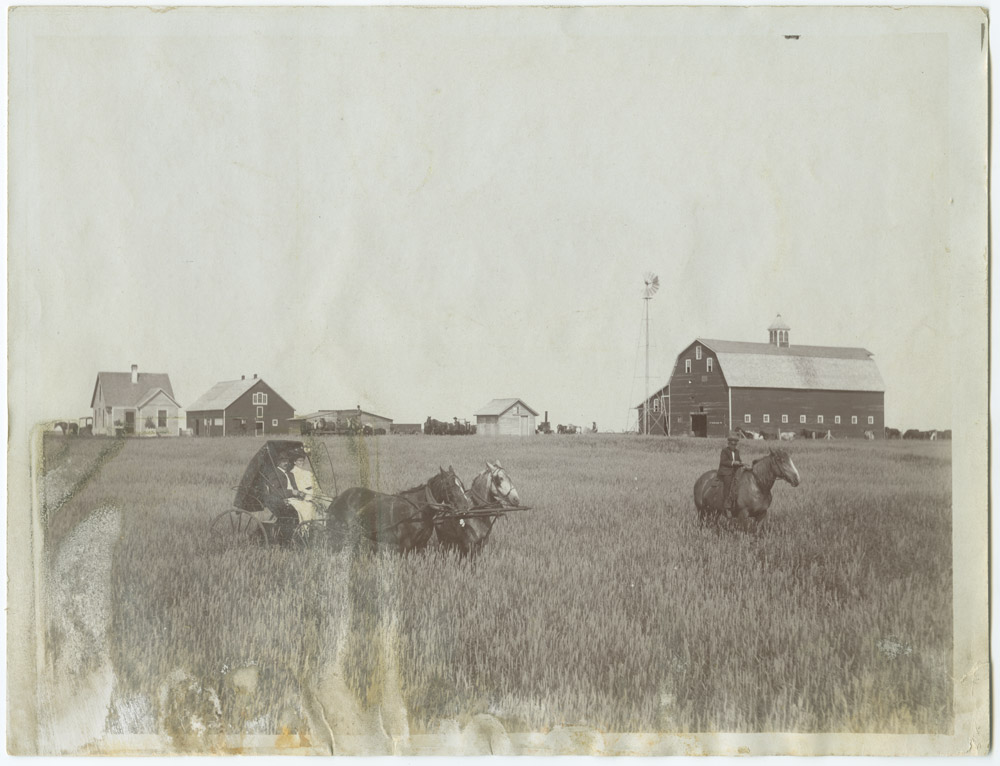
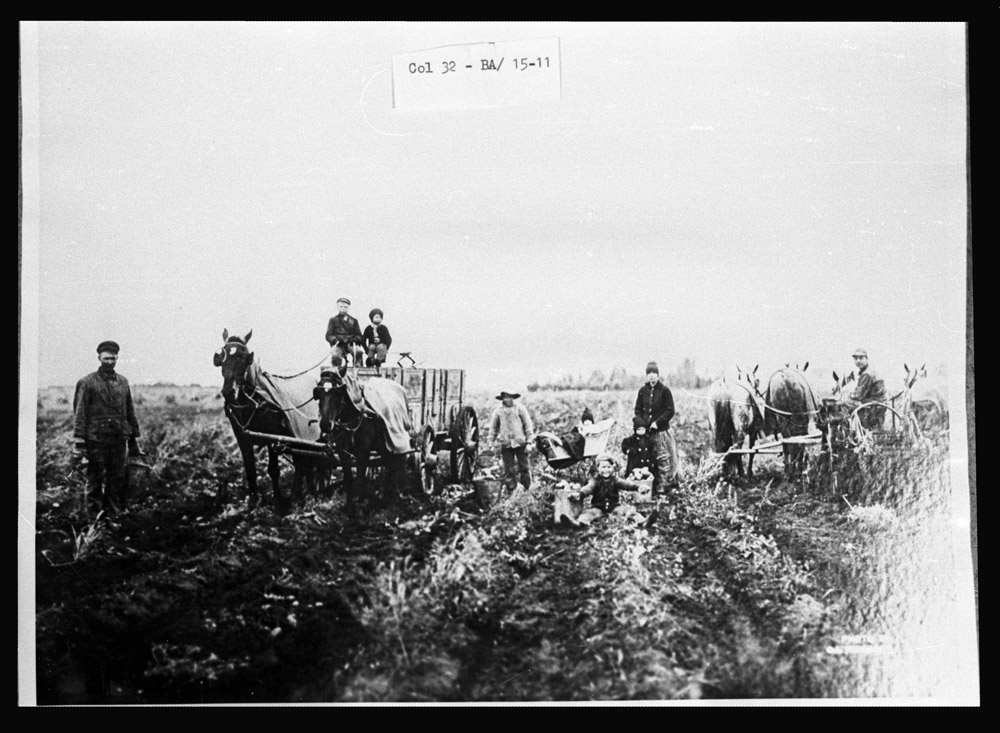
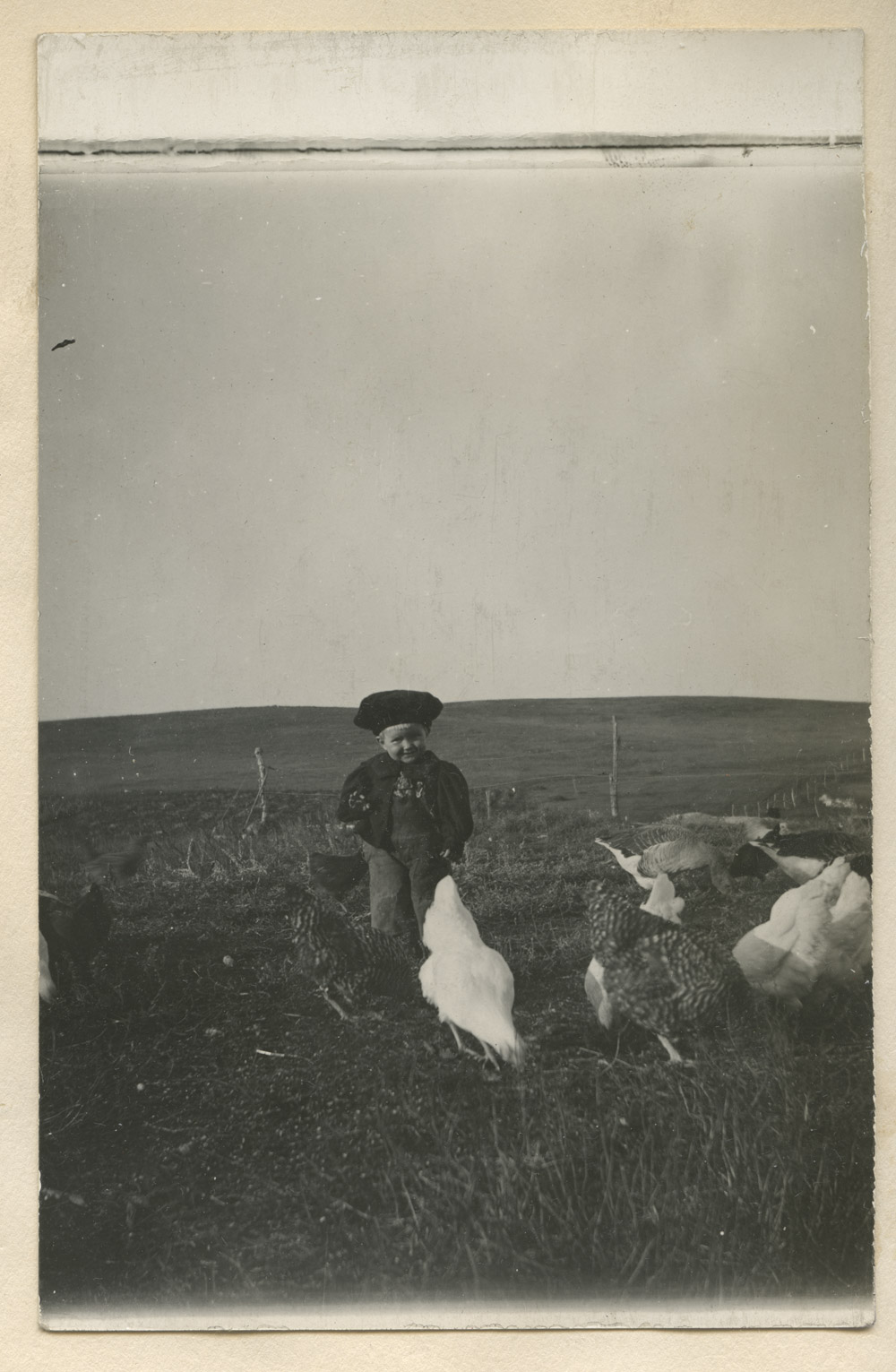
Small farmers usually arrived in Dakota Territory by train. Some got off the train and walked to their new land. Others rode in wagons to locate their land claim. If they arrived early in the spring, they plowed a field right away. Part of the field was usually planted to potatoes for the family’s food supply. The rest of the land was planted to wheat or flax. Farmers were surprised and happy with the good crops they got from the first plowing which was also called breaking.
A homestead claim cost the farmer $14.00. That was the filing fee at the U.S. Land Office where the claim was registered. Because the registration fee was so low, many people talked about going to Dakota for “free” land. But there were other costs. Every homesteader had to build a house, dig a well, and feed the family. If they didn’t have a horse, an ox, or a milk cow, they had to borrow livestock to pull the plow until they could afford to buy a horse. A good plow horse might cost $75 in the 1880s. They also had to buy seed. One historian has estimated that the actual cost of homesteading was about $1,000 ($23,400 today). (See Image 16.) That amount covered the costs of transportation, seed for the garden and fields, livestock, and living expenses until the crops were harvested.
Dakota has been called a “farmers’ frontier.” That means that farmers came to Dakota to claim or buy land and brought their families with them. Children, especially boys, were important as workers on the farm. (See Image 17.) Boys twelve years of age often walked behind the plow or guided the horse or ox pulling the plow. Younger children and girls fed chickens and collected eggs. (See Image 18.) Children as young as five years old were in charge of younger children when both the mother and father worked in the fields. Everyone in the family had a job on a homestead farm.
Farming in Dakota was difficult in the early years (1870 – 1920). Prices for wheat were low, sometimes only 40 cents per bushel. There were many threats to the wheat crop including grasshoppers, rust, hail, and frost. In addition, the fertility of the soil (the nutrients that helped the wheat grow) diminished with each passing year. Family farmers could not afford to put a portion of their land into alternative crops or let it rest for a year to re-gain the nutrients. In 1890, the year after North Dakota became a state, many farm families had to look to their churches, neighbors, and the state for help because the crops had been damaged by drought.
When hard times came, some families left to find another place to live or they moved to a city. Others stayed and kept building their farms. More people kept coming to North Dakota because they thought there would be good opportunities for their families here. In 1890, North Dakota had 27, 611 farms. By 1920, there were 77,690 farms. The population grew, too. In 1890 there were 182,719 people in North Dakota. By 1920, there were 646,872 in the state, and 61% (393,622) of them lived on farms.
Why is this important? With so many people living and working on farms and ranches, agriculture became the backbone of North Dakota’s economy and population at statehood in 1889. All of these farm families had to have a way to send their crops to market, so railroads built lines across the state and into small towns. Farm communities built schools and churches. Small towns grew up along the railroad lines where farmers could buy things they needed and have a place to sell their crops. Farmers took an interest in politics. Many farmers served in the state legislature and in county and township government. Slowly, but steadily, with the hard work of farm families, North Dakota grew into a state with a strong economy and close-knit communities.
Equipment and Labor
Oliver Dalrymple and other bonanza farmers purchased the newest equipment as soon as it was available. Small farmers had to manage equipment differently. When breaking a homestead field, farmers often borrowed equipment or livestock, if they had neighbors to borrow from. Oxen worked best for breaking a field. The sod was dense and heavy and oxen could pull the breaking plow through the field more efficiently than horses. The breaking plow was a different piece of equipment from the plows that farmers would use after the fields had been broken. It was not financially efficient to purchase both a breaking plow and a regular plow. In either case, farmers usually walked behind the single-bottom plow while someone, perhaps a child, walked beside the oxen to keep them in a straight line. Once the fields were broken, a team of horses was used to plow and pull harvest equipment. Horses were easier to manage than oxen, and walked faster. However, much hand labor was involved in farming in the 19th century.
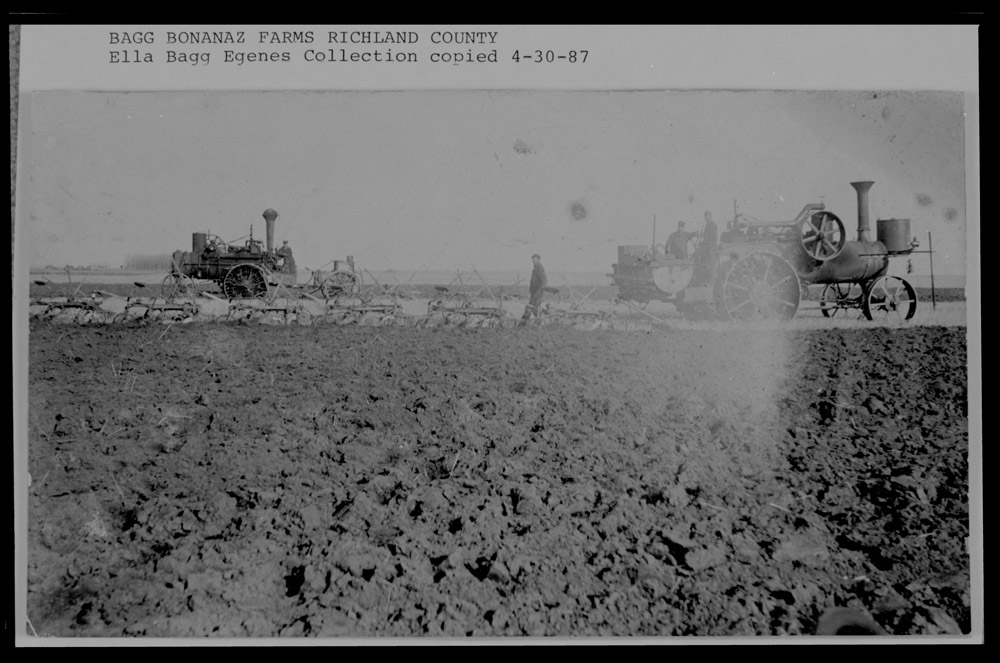
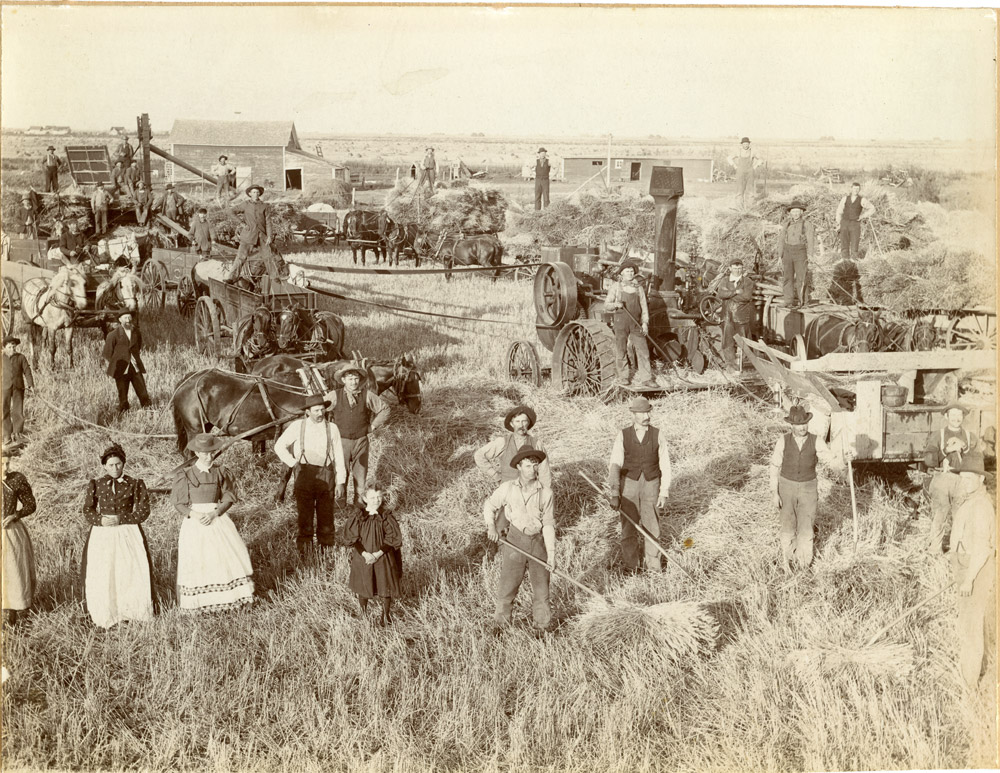
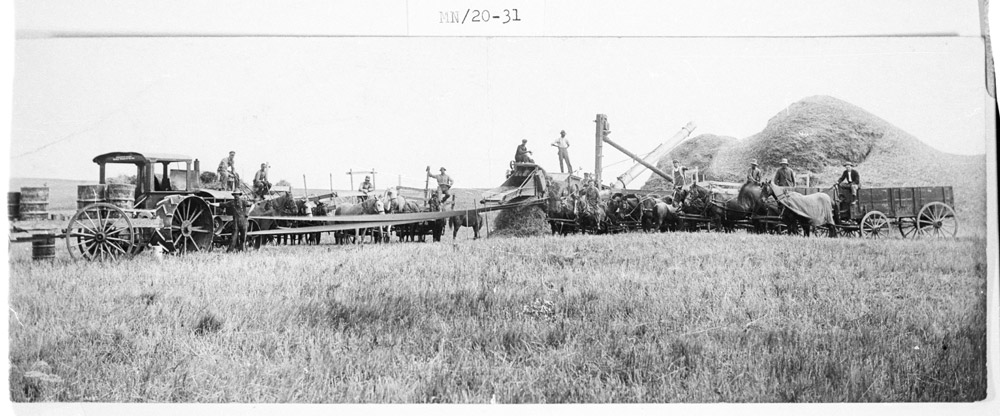
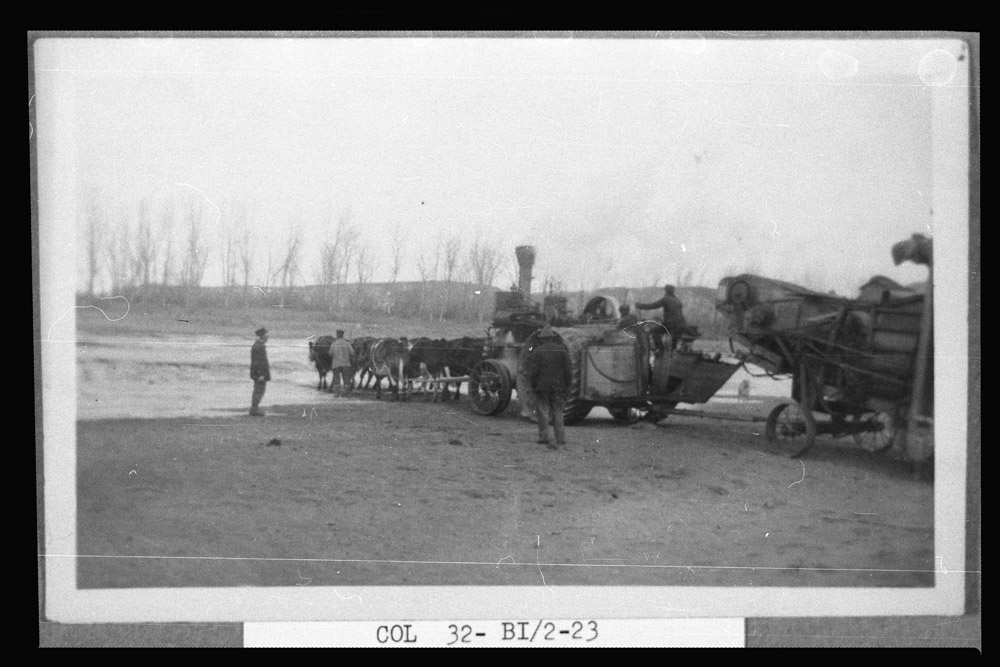
When motorized equipment became available around 1915, some farmers were eager to purchase the new equipment. (See Image 20.) Tractors and threshing engines allowed the farmers to finish their work much faster. Farmers with power equipment often considered buying more land. More land meant more grain to sell in the fall.
Farmers who wanted to purchase a tractor that could pull a wider plow (four or more plowshares) had to have some extra money to spend. In 1917, Ford Motor Company made a Fordson tractor that sold for $750 ($13,276.79 today.) The tractor would increase farm productivity. Extra production would help offset the cost of the tractor. However, in 1910, the average farm netted an income of about $400 ($9,708 today.) A farmer who wanted to buy a tractor had to have some savings or good credit at the bank.
Threshing engines were also costly to buy and to maintain. Threshing engines provided the power for the thresher which did not have its own power. (Old threshers are frequently seen on farm hillsides today.) Farmers generally used two ways to get their threshing done. (See Image 22.) They might hire a threshing crew to come to the farm. (See Image 23.) The crew brought a thresher and a threshing engine, such as a Rumely. The farmer and his wife had to feed and house the threshing crew until the job was done. The threshing crew would travel from farm to farm until the fall threshing was done, or winter weather ended the operation. (See Image 24.)
The other way farmers could thresh the grain was to form a threshing ring with the neighbors. A threshing ring might buy threshing equipment as a group. One farmer might buy threshing equipment and take it from farm to farm. The neighborhood farmers formed the labor pool for the ring. Only the man who owned the threshing rig would be paid. Everyone else gave their own labor with the expectation that their neighbors would return the favor.
Some farmers utilized power equipment, but kept their horses. Tractors were expensive and did not have offspring to replace them as horses did. Farmers who kept horses never worried about starting the engine in the winter. However, horses could not work efficiently in extreme heat and had to be rested for a while every day.
Why is this important? Modernizing farms brought many changes to North Dakota. Farms became larger which increased farm income. Many farmers wanted to give at least 160 acres to each of their sons when the sons married, so it was important to acquire more land.
Farms with power equipment could produce more tons of crops. World War I (The Great War) broke out in 1914 in Europe. The greater efficiency of motorized farm equipment allowed North Dakota farmers to produce food to feed the people of the United States and Europe, even though farm workers were hard to find during the war.
The extra income from motorized farming allowed farmers to buy automobiles. Farm families were able to go to town more often–even weekly–with automobiles. Children could attend high school in town. Eventually, automobiles led to the closing of small rural schools and churches which had formed the basis of rural communities. However, farm families were able to participate in town activities and contributed to the growth of small towns.


